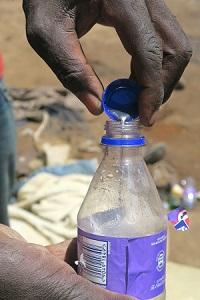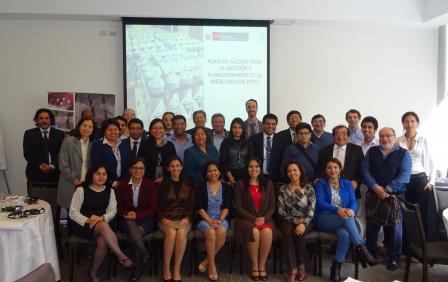International Actions for Reducing Mercury Emissions and Use
- Data collection and inventory development,
- Source characterization, and
- Best practices for emissions and use reduction.
In 2013, the United States joined the Minamata Convention on Mercury, a multilateral environmental agreement that addresses specific human activities which are contributing to widespread mercury pollution. The Minamata Convention entered into force in 2017. Implementation of this agreement will help reduce global mercury pollution over the coming decades.
Learn about EPA's International Work on Mercury:
 Mercury is used extensively in artisanal and small scale gold mining, often with unsafe techniques. Photo credit: Malgorzata Stylo.
Mercury is used extensively in artisanal and small scale gold mining, often with unsafe techniques. Photo credit: Malgorzata Stylo. On this Page:
On other pages:
- Minamata Convention on Mercury
- Mercury Emissions: The Global Context
- Reducing Mercury Pollution from Artisanal and Small-Scale Gold Mining
- Artisanal and Small-Scale Gold Mining Without Mercury
UNEP Global Mercury Partnership
- Artisanal and Small-Scale Gold Mining (ASGM): Exit Natural Resources Defense Council (NRDC); United Nations Industrial Development Organization (UNIDO).
- Mercury Releases from Coal Combustion: Exit International Energy Agency Clean Coal Center.
- Mercury Cell Chlor-alkali Production:ExitGovernment of the United States (Environmental Protection Agency); United Nations Industrial Development Organization (UNIDO).
- Mercury in Products: ExitGovernment of the United States (Environmental Protection Agency).
- Mercury Air Transport and Fate Research: ExitConsiglio Nazionale delle Ricerche (CNR) Institute for Atmospheric Pollution, Italy; Biodiversity Research Institute, U.S.A.
- Mercury Waste Management: ExitGovernment of Japan.
- Mercury Supply and Storage: ExitGovernment of Spain; Government of Uruguay.
- Mercury Releases from the Cement Industry: Exit World Business Council For Sustainable Development; Cement Sustainability Initiative.
Learn more:
- EPA’s involvement and contribution to the Global Mercury Partnership
- Official UNEP Partnership Page Exit
Regional Activities on Mercury
Arctic
The Arctic Council, in collaboration with the Norwegian institute for water research (NIVA), is working on a proposed project to evaluate risks of mercury releases to the Arctic environment. The project will include three selected ACAP member state localities (in Canada, Norway, and Russia) with potential point and non-point sources of mercury input to the Arctic Ocean.
These localities will be chosen in accordance with explicit selection criteria, including their potential for representing various other sites in the Arctic. An important outcome of the project will be a prioritized list of effective actions and investments for reduction of mercury risks to the Arctic populations and environment.
Learn more:
Asia
Bilateral Cooperation
Asia Pacific Mercury Monitoring Network
APMMN began operating in 2015 with three pilot sites in Thailand, Indonesia, and Vietnam. Since then, the network has expanded. In 2018-19, the most recent new sites began operating in Philippines, Sri Lanka, and a second in Vietnam. Through APMMN’s equipment donation and technical trainings, these countries are routinely monitoring mercury in rainwater for the first time.
Latin America
Mercury Management, Storage and Disposal Action Planning in Peru
 Participants at mercury management, storage and disposal action planning workshop (December 2017).
Participants at mercury management, storage and disposal action planning workshop (December 2017).The United States and Peru are both Parties to the Minamata Convention on Mercury, which includes Articles specific to mercury storage (Article 10), disposal (Article 11) and capacity building/technical assistance (Article 14). The United States and Peru signed an Environmental Cooperation Agreement (ECA), which entered into force in 2009. The 2015-2018 update to the Environmental Cooperation Work Program identifies "Institutional and Policy Strengthening for Effective Implementation and Enforcement of Environmental Laws" as a priority area.
In 2017, EPA provided technical support to Peru’s Ministry of Environment (MINAM) on managing, storing and disposing of identified stocks and supplies of mercury in Peru. EPA supported MINAM in organizing and hosting a multisector, public-private stakeholder workshop in Lima to develop action plans which were integrated into Peru’s article-by-article Minamata Implementation Plan.
EPA continues to support Peru’s advancement in the area of mercury management, including interim storage and final disposal of mercury, through work funded by the U.S. Department of State. Additionally, EPA is working through UN Environment’s Global Mercury Partnership Exitto provide additional technical expertise to the Government of Peru and its industries in support of their implementation of the Minamata Convention on Mercury.
Localized Mercury Management and Interim Storage in Colombia
Colombia is signatory to the Minamata Convention on Mercury, currently working toward full ratification. Under the United States—Colombia Trade Promotion Agreement (TPA), which entered into force on May 15, 2012, both Parties committed to effectively enforce their own domestic environmental laws and adopt, maintain, and implement laws, regulations, and all other measures to fulfill their obligations under covered multilateral environmental agreements, like the Minamata Convention.
As a part of the United States’ bilateral cooperation with Colombia under the TPA, in support of Minamata Convention obligations to reduce the use, emission and release of toxic mercury into the global environment, EPA continues to engage in a number of capacity building activities with Colombian Ministries, through the US Embassy in Bogota. Technical support has been focused on the subject of local management and interim storage of mercury from artisanal and small-scale gold mining (ASGM) operations. EPA experts have shared their experiences, training local authorities in the use of technologies for testing air, soil and water in order to detect the presence of mercury at mine sites.
Past Activities
Arctic
EPA provided support for the development of Russia's first comprehensive mercury emission inventory (now updated and captured in UNEP’s 2013 Global Atmospheric Mercury Assessment)Exit EPA has also supported:
- the first regional (eight-country) Arctic emission inventory (also captured in UNEP’s 2008 Global Atmospheric Mercury Assessment) and
- emissions reduction demonstration projects in close cooperation with the UNEP Global Mercury Partnership and other organizations.
Learn More:
- The U.S. Mercury Emission Inventory for the Arctic Council Action Plan (PDF) (10 pp, 42 K, About PDF)
Europe
- Aims to cut emissions from industrial sources (iron and steel industry, non-ferrous metal industry), combustion processes (power generation, road transport), and waste incineration.
- Includes strict limit values and deadlines for emissions reductions for new and existing stationary sources and suggests Best Available Techniques (BAT) for these sources.
- Contains measures to reduce emissions of heavy metals emissions from products, such as leaded gasoline and mercury in batteries, through the mandatory phase-out of leaded gasoline and mandatory mercury concentration limits for certain types of batteries.
Great Lakes Binational Toxics Strategy
The 1997 Canada-United States Strategy for the Virtual Elimination of Persistent Toxic Substances in the Great Lakes Basin, known as the Great Lakes Binational Toxics Strategy, created a framework for addressing mercury pollution in the Great Lakes Basin by establishing a goal of "virtual elimination" of anthropogenic mercury inputs to the Great Lakes, as well as by establishing goals of reducing U.S. mercury emissions and use by 50% and reducing Canadian mercury releases by 90%.
The Strategy established a workgroup of U.S. and Canadian federal, state and local government officials, industry, and environmental groups, who shared information about cost-effective mercury reduction approaches. The Strategy was successful in gaining commitments for voluntary mercury reduction from the chlor-alkali industry, which committed to reduce its mercury use by 50% (actually achieving more than 95%); from the American Hospital Association for the virtual elimination of mercury from hospital waste, and from northwest Indiana steel mills; who inventoried their mercury-containing equipment and reduced it by more than 80%. The workgroup has ceased its activity, having achieved its interim reduction goals.
North American Regional Action Plan on Mercury
New England Regional Mercury Action Plan
Russia
EPA has taken a role in projects to reduce the use and release of mercury in several industrial sectors:
- EPA has assisted Russian chlorine producers in upgrading plant processes and equipment to reduce releases by almost 1 metric ton per year.
- EPA helped the Chlor-Alkali Partnership create aglobal inventory of mercury-cell chlor-alkali facilities. Exit
- In collaboration with various Russian institutes, the United Nations Environmental Program (UNEP) and the Swedish Environmental Institute, EPA concluded a multi-year program to demonstrate controlling mercury emissions using activated carbon injection technologies (both standard and brominated) at a Russian coal-fired power plant.
- View the scientific report: Mercury Emissions Capture Efficiency with Activated Carbon Injection at a Russian Coal-Fired Thermal Power Plant.
- Mercury is also emitted in the process of zinc smelting. To address this, EPA helped develop a more robust mercury emission inventory in China, in order to understand how much mercury is coming from the zinc sector. EPA also supported studies on mercury emissions from other nonferrous metals production.
Contacts
